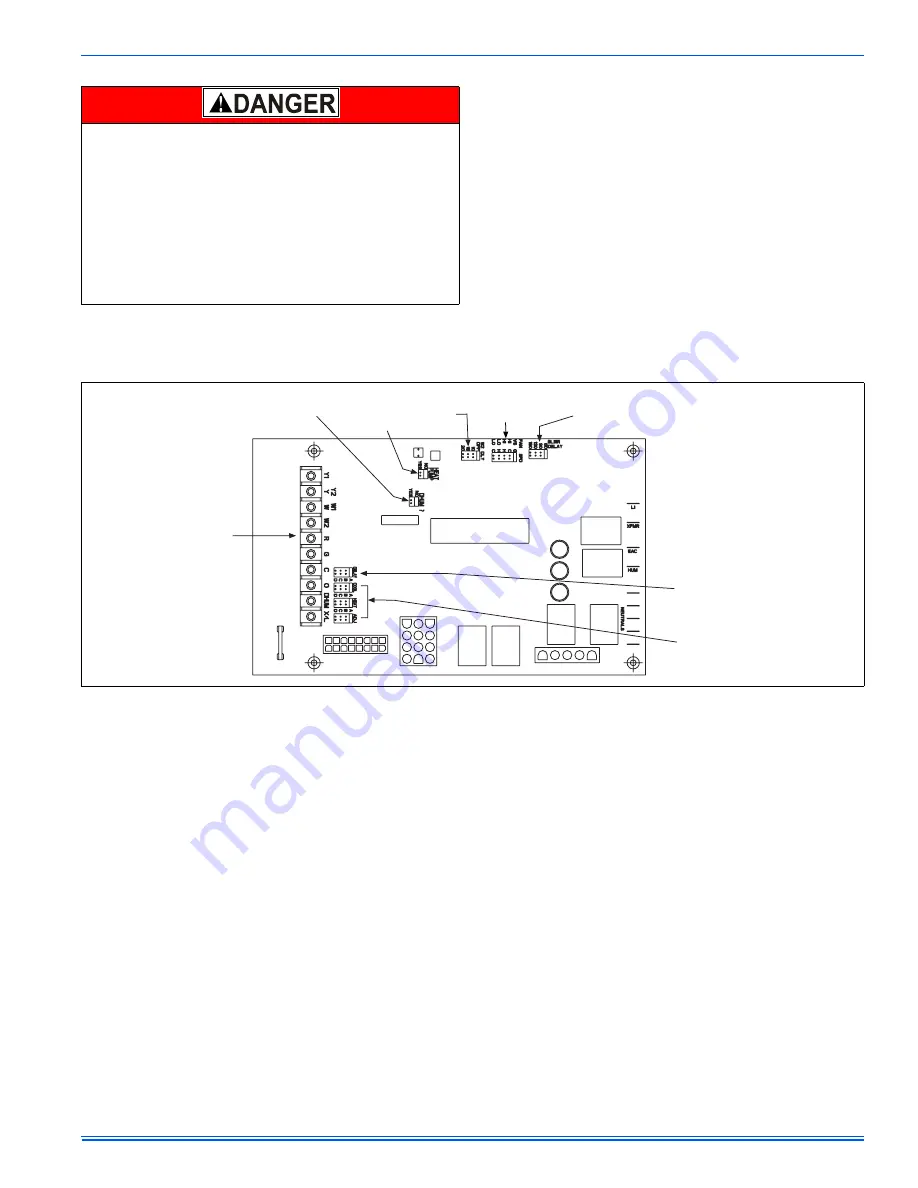
271001-UIM-A-0407
Unitary Products Group
23
ADJUSTMENT OF TEMPERATURE RISE
The temperature rise, or temperature difference between the return air
and the heated supply air from the furnace, must be within the range
shown on the furnace rating plate and within the application limitations
as shown in Table 8.
After about 20 minutes of operation, determine the furnace temperature
rise. Take readings of both the return air and the heated air in the ducts,
about six feet (1.83 m) from the furnace where they will not be affected
by radiant heat. Increase the blower speed to decrease the temperature
rise; decrease the blower speed to increase the rise.
VARIABLE SPEED MOTORS
The variable speed motor must be configured so the blower will provide
a sufficient airflow so that the furnace operates within the temperature
rise range on the rating plate and within the application limitations
shown in Table 8 in these Instructions.
ADJUSTMENT OF FAN CONTROL SETTINGS
This furnace is equipped with a time-on/time-off heating fan control. The
fan-on delay is fixed at 30 seconds. The fan-off delay has 4 settings
(60, 90, 120 and 180 seconds). The fan-off delay is factory set to 120
seconds. The fan-off setting must be long enough to adequately cool
the furnace, but not so long that cold air is blown into the heated space.
The fan-off timing may be adjusted by positioning the jumper on two (2)
of the four (4) pins as shown in Figure 27.
Heating and Cooling Airflow
The heating and the cooling airflows are preset at the factory. The heat-
ing airflow is set to the maximum CFM. The cooling airflow is set to pro-
vide 90 percent of the maximum CFM. The heating and cooling airflows
must be field adjusted to match the HVAC system at installation. See
Table 16 for the HEAT, COOL and ADJ jumper settings to use for spe-
cific airflows.
Delay Taps Selection
The set of jumper pins on the control board labelled "DELAY" are used
to set the delay profiles for the furnace. These can be chosen so as to
maximize the comfort and sound levels for various regions of the coun-
try.
Tap A
is the default profile. It provides a 15-second ramp-up from zero
airflow to full capacity and a 15-second ramp-down from full capacity
back to zero airflow. Whenever there is a change in airflow mode, such
as from low heat to high heat, the motor will take 15 seconds to ramp
from one speed to the other.
Tap B
is the humid profile. This profile is best-suited for installations
where the humidity is frequently very high during cooling season, such
as in the southern part of the country. On a call for cooling, the blower
will ramp up to 50% of full capacity and will stay there for two (2) min-
utes, then will ramp up to 82% of full capacity and will stay there for five
(5) minutes, and then will ramp up to full capacity, where it will stay until
the wall thermostat is satisfied. In every case, it will take the motor 15
seconds to ramp from one speed to another.
Tap C
is the dry profile. This profile is best suited to parts of the country
where excessive humidity is not generally a problem, where the sum-
mer months are usually dry. On a call for cooling the motor will ramp up
to full capacity and will stay there until the thermostat is satisfied. At the
end of the cooling cycle, the blower will ramp down to 50% of full capac-
ity where it will stay for 60 seconds. Then it will ramp down to zero. Any
ramp up to a higher speed will take 30 seconds and any ramp down to a
lower speed (or off) will take 60 seconds.
Tap D
is the normal profile, best suited for most of the country, where
neither excessive humidity nor extremely dry conditions are the norm.
On a call for cooling, the motor will ramp up to 63% of full capacity and
will stay there for 90 seconds, then will ramp up to full capacity. At the
end of the cooling cycle, the motor will ramp down to 63% of full capac-
ity and will stay there for 30 seconds, then will ramp down to zero. In
every case, it will take the motor 15 seconds to ramp from one speed to
another.
The temperature rise, or temperature difference between the return
air and the supply (heated) air from the furnace, must be within the
range shown on the furnace rating plate and within the application
limitations shown in Table 8 “RATINGS & PHYSICAL/ELECTRICAL
DATA”.
The supply air temperature cannot exceed the “Maximum Supply
Air Temperature” specified in these instructions and on the fur-
nace rating plate. Under NO circumstances can the furnace be
allowed to operate above the Maximum Supply Air Temperature.
Operating the furnace above the Maximum Supply Air Temperature
will cause premature heat exchanger failure, high levels of Carbon
Monoxide, a fire hazard, personal injury, property damage, and/or
death.
FIGURE 27:
Furnace Control Board
CONTINUOUS
FAN SPEED
JUMPER
BLOWER
OFF DELAY
JUMPER
HI HEAT
DELAY
JUMPER
HEAT
DELAY
JUMPER
DEHUMIDISTAT
JUMPER
LOW
VOLTAGE
TERMINALS
BLOWER
SPEED
JUMPERS
COOLING
PROFILE
JUMPER






































